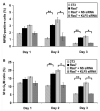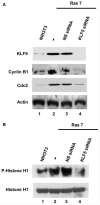Krüppel-like factor 5 promotes mitosis by activating the cyclin B1/Cdc2 complex during oncogenic Ras-mediated transformation
- PMID: 16102754
- PMCID: PMC1626271
- DOI: 10.1016/j.febslet.2005.07.053
Krüppel-like factor 5 promotes mitosis by activating the cyclin B1/Cdc2 complex during oncogenic Ras-mediated transformation
Abstract
We previously showed that the zinc finger-containing transcription factor Krüppel-like factor 5 (KLF5) is important in mediating transformation by oncogenic H-Ras through induction of cyclin D1 expression and acceleration of the G1/S transition of the cell cycle. Here we present evidence of a role for KLF5 in accelerating mitotic entry in H-Ras-transformed NIH3T3 fibroblasts. When compared with non-transformed parental NIH3T3 cells, H-Ras-transformed fibroblasts exhibit an increase in mitotic index, levels of cyclin B1 and Cdc2, and cyclin B1/Cdc2 kinase activity. Inhibition of KLF5 expression in H-Ras-transformed cells with KLF5-specific small interfering RNA (siRNA) results in a decrease in each of the aforementioned parameters, with a concomitant reduction in the transforming potential of the cells. Conversely, over-expression of KLF5 in NIH3T3 cells leads to an increase in the promoter activity of the genes encoding cyclin B1 and Cdc2. These results indicate that KLF5 accelerates mitotic entry in H-Ras-transformed cells by transcriptionally activating cyclin B1 and Cdc2, which leads to an increase in cyclin B1/Cdc2 kinase activity. Extending our previous observation that KLF5 activates cyclin D1 transcription to promote G1/S transition, our current results further support a crucial function for KLF5 in mediating cellular transformation caused by oncogenic H-Ras.
Figures





Similar articles
-
Krüppel-like factor 5 mediates the transforming activity of oncogenic H-Ras.Oncogene. 2004 Apr 22;23(19):3404-13. doi: 10.1038/sj.onc.1207397. Oncogene. 2004. PMID: 15077182 Free PMC article.
-
Requirement of Krüppel-like factor 4 in preventing entry into mitosis following DNA damage.J Biol Chem. 2004 Feb 6;279(6):5035-41. doi: 10.1074/jbc.M307631200. Epub 2003 Nov 19. J Biol Chem. 2004. PMID: 14627709 Free PMC article.
-
Cell cycle attenuation by p120E4F is accompanied by increased mitotic dysfunction.Cell Growth Differ. 2001 Oct;12(10):505-16. Cell Growth Differ. 2001. PMID: 11682462
-
Regulation of the G2/M transition by p53.Oncogene. 2001 Apr 5;20(15):1803-15. doi: 10.1038/sj.onc.1204252. Oncogene. 2001. PMID: 11313928 Review.
-
Translational control during mitosis.Biochimie. 2005 Sep-Oct;87(9-10):805-11. doi: 10.1016/j.biochi.2005.04.014. Biochimie. 2005. PMID: 15951098 Review.
Cited by
-
Krüppel-like factor (KLF) 5 mediates cyclin D1 expression and cell proliferation via interaction with c-Jun in Ang II-induced VSMCs.Acta Pharmacol Sin. 2010 Jan;31(1):10-8. doi: 10.1038/aps.2009.185. Epub 2009 Dec 28. Acta Pharmacol Sin. 2010. PMID: 20037604 Free PMC article.
-
A colon cancer-derived mutant of Krüppel-like factor 5 (KLF5) is resistant to degradation by glycogen synthase kinase 3β (GSK3β) and the E3 ubiquitin ligase F-box and WD repeat domain-containing 7α (FBW7α).J Biol Chem. 2014 Feb 28;289(9):5997-6005. doi: 10.1074/jbc.M113.508549. Epub 2014 Jan 7. J Biol Chem. 2014. PMID: 24398687 Free PMC article.
-
Unraveling the triad of hypoxia, cancer cell stemness, and drug resistance.J Hematol Oncol. 2025 Mar 18;18(1):32. doi: 10.1186/s13045-025-01684-4. J Hematol Oncol. 2025. PMID: 40102937 Free PMC article. Review.
-
The role of Krüppel-like factors in the reprogramming of somatic cells to induced pluripotent stem cells.Histol Histopathol. 2009 Oct;24(10):1343-55. doi: 10.14670/HH-24.1343. Histol Histopathol. 2009. PMID: 19688699 Free PMC article. Review.
-
Mammalian Krüppel-like factors in health and diseases.Physiol Rev. 2010 Oct;90(4):1337-81. doi: 10.1152/physrev.00058.2009. Physiol Rev. 2010. PMID: 20959618 Free PMC article. Review.
References
-
- Kadonaga JT, Carner KR, Masiarz FR, Tjian R. Isolation of cDNA encoding transcription factor Sp1 and functional analysis of the DNA binding domain. Cell. 1987;51:1079–1090. - PubMed
-
- Bieker JJ. Krüppel-like factors: three fingers in many pies. J. Biol. Chem. 2001;276:34355–34358. - PubMed
-
- Black AR, Black JD, Azizkhan-Clifford J. Sp1 and krüppel-like factor family of transcription factors in cell growth regulation and cancer. J. Cell. Physiol. 2001;188:143–160. - PubMed
Publication types
MeSH terms
Substances
Grants and funding
LinkOut - more resources
Full Text Sources
Other Literature Sources
Research Materials
Miscellaneous

